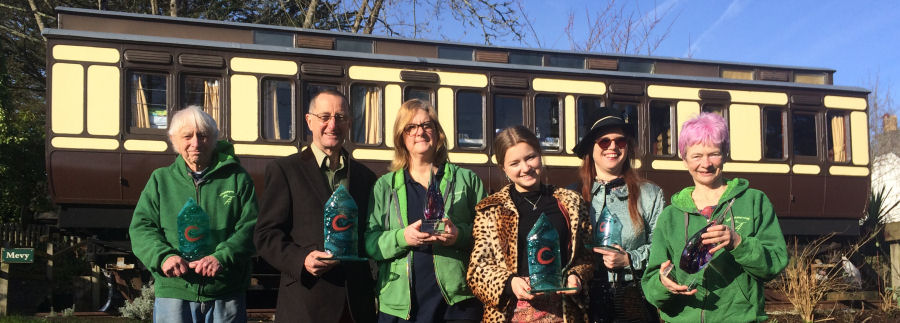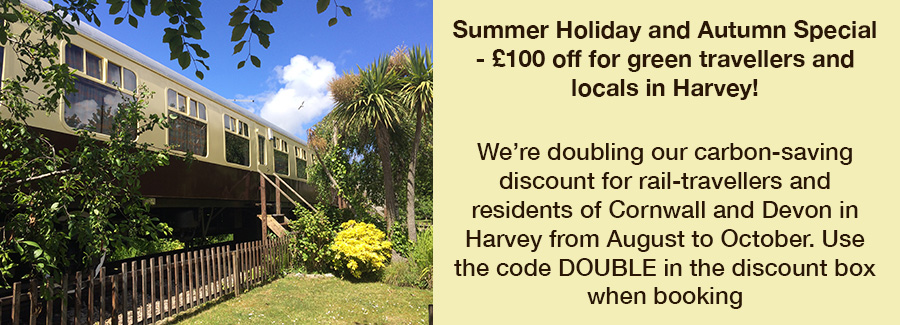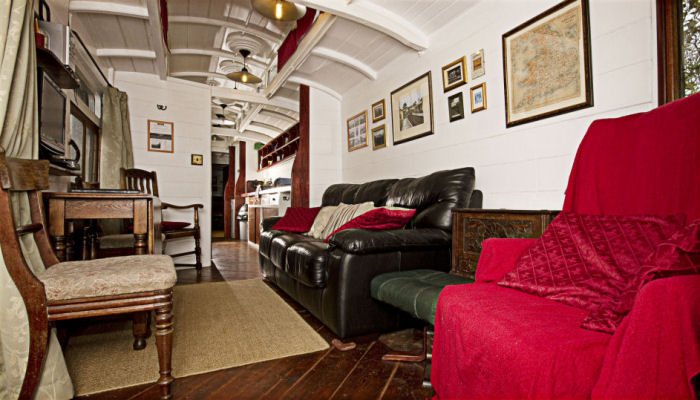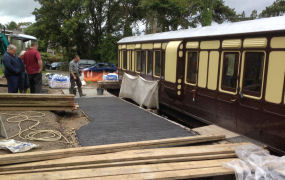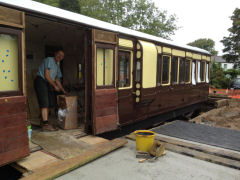Also on this page: History of Railholiday | Carriage Histories
| FAQ'sAbout Railholiday
Railholiday began rescuing derelict carriages and converting them into self catering holiday accommodation in 1996. The business is based at St Germans in South East Cornwall, UK where we have four carriages available for letting with more pending. There is another carriage, Harvey, located at Hayle in West Cornwall. Environmental sustainability is very important to the owners of the business, Dave and Lizzy Stroud. You can read more about our green journey here, for accessibility click here, and for the legal stuff click here. To read our latest newsletter, follow this link.
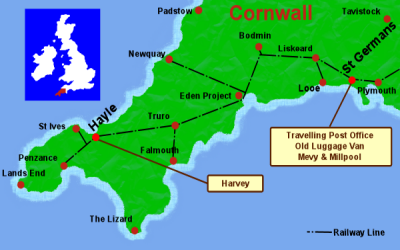 The contact details for the company are:
The contact details for the company are:
Railholiday Ltd,
Haparanda Station
St Germans
SALTASH
Cornwall
PL12 5LU
Email: office@railholiday.co.uk
Telephone: Office - 01503 230 783 | Lizzy - 07776 261 192 | Dave - 07776 261 277
We were delighted to be featured in Welcome To Now's video What Do People Do All Day and feel it gives a fairly good flavour of the nature of the business. For a slightly less tongue in cheek description, do continue reading....
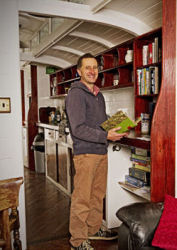
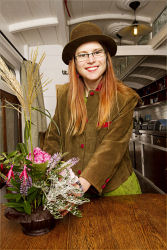

Since the early days our team has grown to become a multi talented and varied one. Here are our core staff;
David and Lizzy Stroud - company directors and their children, Walter and Poppy.
Lizzy is a musician by trade. Having discovered that a Music and English degree does not offer the protection against gainful employment she had originally hoped, she now heads the areas of marketing, environmental growth and gardening. Dave is an engineer, originally having his own business in agricultural machinery design and construction. He is now in charge of the conversion work, accounts and practicals. Dave does the construction side of the website, while Lizzy deals with content. Together as a hobby they play in the band Wurlitza and add live soundtracks to silent films. Our children have grown with the business. When we first started we were expecting our first child Walter. Walter is now doing a PhD at the University of Surrey on solar technology. Our daughter Poppy graduated from Arts University Plymouth in 2024 with a degree in Fashion, Media and Marketing, specialising in photography. She has recently moved to London, but she still creates beautiful art work for our Christmas cards.
The St Germans Team
John is our most senior member, chief paint stripper and up-cycler, as well as photographer. With a great knowledge of organic plant care Lil is our chief gardener as well as coming with armfuls of freshly cut flowers from her garden every week. Her talents also include book binding, so she also gets drawn into mail shots and card making.
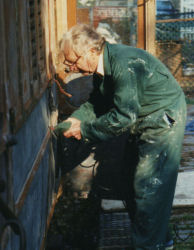
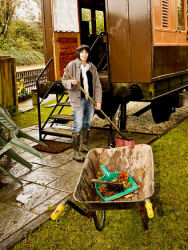
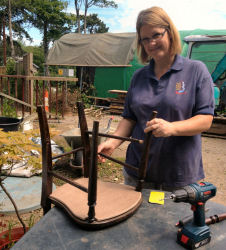
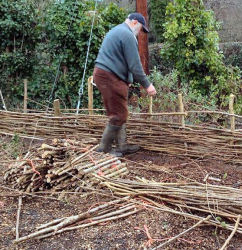
Nicki (Lizzy's sister) is in charge of keeping the carriages spick and span, but can also put her hand to almost anything else, from digger driving to window frame construction. Tony (Lizzy’s Dad) runs a smallholiday at nearby Pommania, which provides the apples for the juice we provide in our welcome pack. The land at Pommania, about five miles from St Germans, was developed by Tony and Lizzy’s Mum Frankie, who was a conservation advisor and oracle on all things environmental. It now is a thirty acre haven for wildlife, and the location for many of our carbon offsetting trees. Tony also makes our hazel fences and helps with other practical things.
Michelle and Lil’s twin sister Glad work with Nicki on the changeovers. Sarah also helps on Friday, keeping the games room looking good, the wood stores topped up and the railings dusted, as well as being the occasional TikTok star. Kath primarily keeps the carriage paintwork looking fresh but will turn her hand to any task assigned, from stuffing envelopes to keeping the staff healthy with her weekly Tai Chi sessions. Lisa comes in on Mondays, to manage the gardens. Our newest member of staff, Julie, helps with the cleaning and office work.
Left to right: Sarah, Nicki, Dave, Lizzy, Kath, Glad, Emily and Lil.
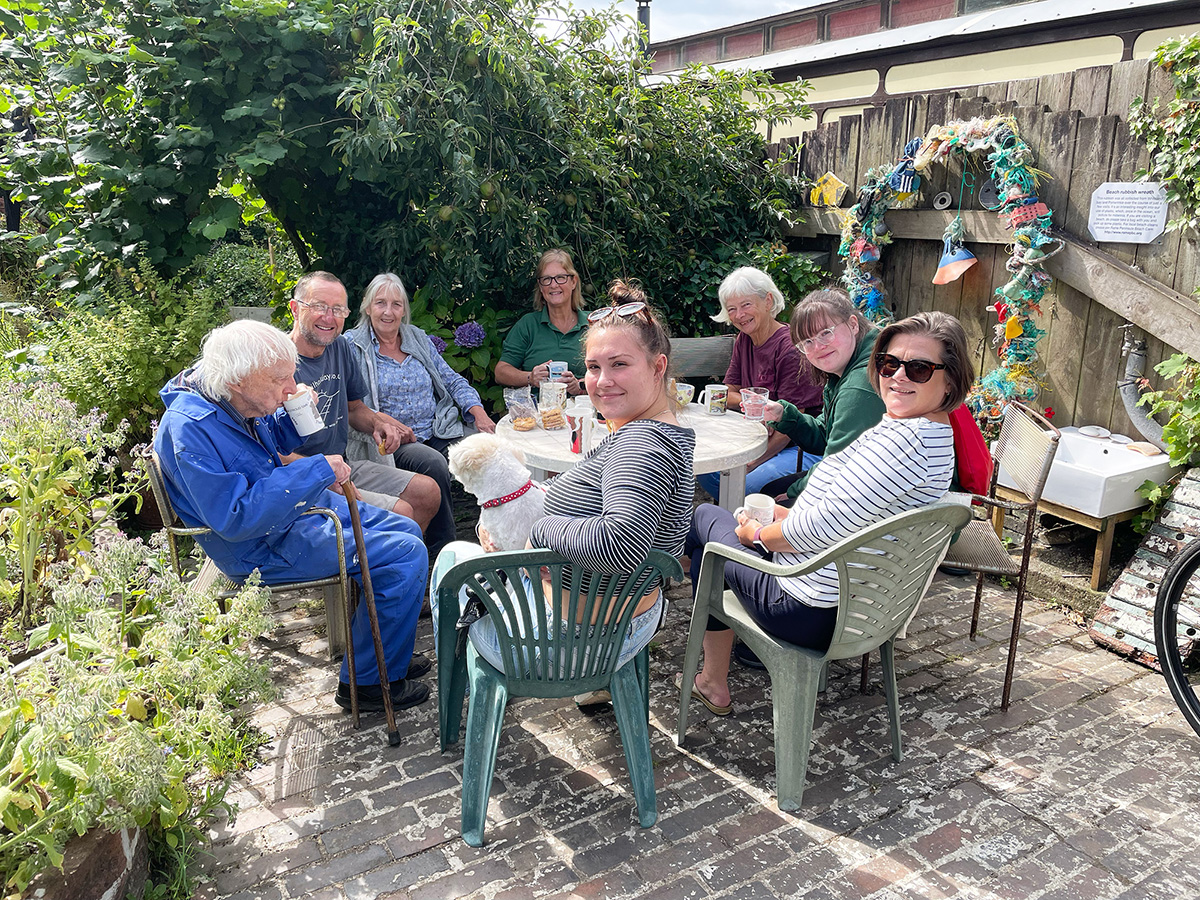
Crib time is an opportunity to chat and for our staff to give input. In this photo, left to right, are John, Dave, Lil, Nic, Ella, Kath, Sarah and Julie.
The Hayle Team
Bob, our wonderful caretaker in Hayle is truly reliable and helpful, sorting out any problems that arise and making sure everything is right for our guests when they arrive in Harvey.

The Railholiday Support Team
While these are our core staff, there are many others who help along the way, and several local tradespeople without whom we would struggle, including Ben Patrick, our wonderful work experience lad of several years turned employee and now moved on to a full time post at the Lappa Valley Railway, Richard Elliott; our local electrician who is always there in our hour of need, Mike Eastment; our local plumber, Paul Ager; Blacksmith, Dave Lock; landscape gardener, Paul and Selina Luscombe Luscombe Upholstery, Irene Vidal Cal, who has been producing fabulous artwork for us initially under the Falmouth University postgraduate placement scheme and now as a fully fledged artist, Lara Kleckham; environmental advisor, Brian Hoskin; artist, Katy Havelock; sign writer and Jacqui Gratton; marketing advisor. In addition we have numerous friends who help us out when deadlines loom, to whom we are always very grateful! Pictured below are a few of these many helpers at a party we held to celebrate completing Mevy.

The History of Railholiday
Becoming the proud owners of a fleet of holiday railway carriages has been something of a surprise to us. It was never really a life decision to take this course, it just happened organically.
In 1992 we bought the derelict railway station building in the pretty village of St Germans and got planning permission to change it into a house. A few years later, while digging the garden we discovered a siding and decided a little carriage body would be the perfect solution for putting up visiting friends and family. Having tracked down our first project, the Old Luggage Van, in a builder’s yard in Liskeard, we set to converting it with the help of a friend who’d had experience of converting camper vans. We decided to let it to the public to help pay for the conversion and soon found we had a good business on our hands among the rail enthusiast fraternity.
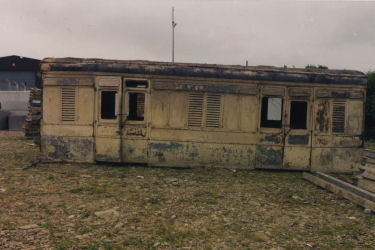

Spurred by the success of The Old Luggage Van, and with the arrival of a tiny son Walter, whose prime obsession was trains, we decided to expand and wanted to offer a similar experience – a train based holiday that could be reached by public transport. We contacted the railway to see if they had anything suitable to let and settled on a large site beside the station in the fascinating coastal town of Hayle. Thus began our second project – a 1957 corridor coach, complete with all the original fixtures and fittings. This also was our first insight into the challenges of moving such a beast! Originally at Bodmin and Wenford, it made its way by road to Hayle on a special low loader and just managed the steep hill up to Hayle station. We held our breath, especially as the whole process was being filmed by the Discovery Channel for their series Amazing Conversions!
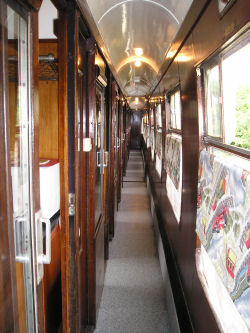
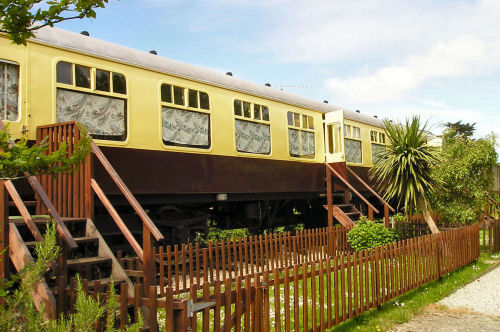
That was a long time ago. Our daughter Poppy was born a few months later and together with Walter we spent many happy months completing the conversion at Hayle, living in the carriage as we worked. We’d obviously caught the bug, because before long we’d found another coach on the internet, this time a historic Victorian Travelling Post Office body that had been behind the City of Truro when it became the first train to exceed 100mph. We decided to look closer to home for a site and arranged to rent a little parcel of land from the local estate on the other side of our station home. The only problem was that it was too small for the coach we’d got our heart set on. There was only one option – to move the Old Luggage Van. This was quite a challenge! Dave had made a replica chassis for the Old Luggage Van with working wheels, but we’d never really put them to the test. With the assistance of our trusty 1954 Fordson Major tractor and friends to help move the track we pulled the Luggage Van across the station forecourt and into its new home.
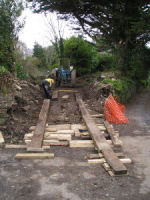
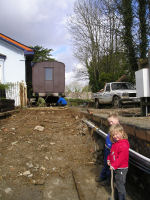
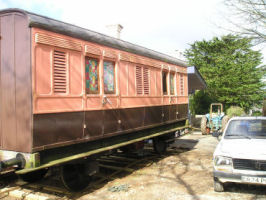
Perhaps here would be a good time to mention one of the greatest challenges of this line of business, other than the obvious ones of planning permission and land leases – coach moving! With a large coach like The Travelling Post Office there are only a few specialist companies in the country that have the equipment to move them, and a grounded body like the Travelling Post Office also needs a large crane. We bought the TPO from Brecon, and needed a crane from Cardiff. The movers, Moveright International, came from Birmingham. When they arrived to pick up the coach they discovered there was nowhere to turn, so had to reverse the 120 foot low loader for nearly three miles back to the nearest major road. We were infinitely grateful to the kind patience of the local Welsh drivers that day! In 2006 we’d completed the conversion and were welcoming guests to our beautiful new coach.
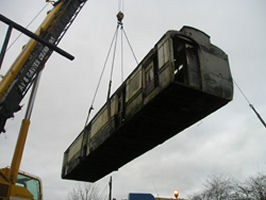
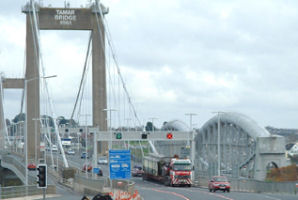
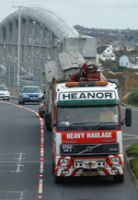
Perhaps the story should have ended here – with Dave continuing his engineering business, Lizzy her music teaching and three holiday lets adding an additional income stream. However we must have been hooked as in 2008 we entered into discussions with the local estate again, who kindly agreed to a long lease on another piece of redundant land below our house.
In our next search for coaches we knew what we wanted – Victorian bodies of about thirty feet in length (easy to move and manageable) and definitely no clerestory roof (lots of extra work in the windows, and a challenge to keep watertight). With the help of a friend, Jon Wood, who had knowledge of carriage bodies, we found a lovely coach – a GWR brake third of 1896, and on eBay purchased another good one – a Taff Valley Railway coach of 1889. We bought a derelict LSWR brake body as a services coach and were feeling fairly smug, but then we had a phone call that threw everything into disarray – the offer of a carriage from Queen Victoria’s Diamond Jubilee train, the first ever GWR dining car (which we’d long hankered after – but that’s another story…) and the last GWR slip coach of 1896. What a dilemma – all three were long (two over 57 feet) and all three had clerestory roofs. We said yes of course.
Mevy, the GWR slip coach, was the last carriage onto site, and the first to be completed. Much research was done into how it should be decorated. We decided to push the boat out and get the finest materials that we could, in keeping with its history, but the end result has been more than worth it. We welcomed our first guests in July 2013. Its opulent interior has meant it is very popular.
Our next challenge was our GWR brake third coach. This proved to be far from straightforward, as when the panels were removed for restoration we found the internal frame to be rotten. So we used sweet chestnut from our woodland and carved each piece by hand. A time consuming work! We also repaired the doors using oak from redundant pallets, and in this way were able to ensure the work was as low impact and environmentally friendly as it could be. In October 2017 our first guest, Rosie, stayed in Millpool. She was brilliant at advising us what we needed to do to make it perfect for wheelchair users. We gained an M3 rating from the National Accessibility Scheme in the autumn of 2018, and in the same year won a Visit Cornwall bronze award for accessible tourism.
At the time of writing (January 2020) the GWR dining carriage has been fitted up with shelves and a flower arranging room and studio are almost complete in one end. This will enable us to empty the Royal Saloon, which is next in line for attention. So Watch this space!
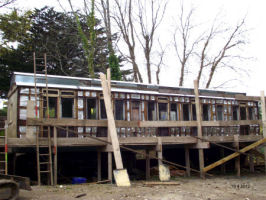
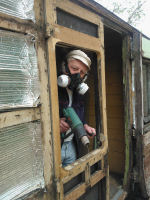
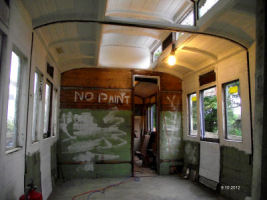
So in a nutshell carriage holidays are a great fun business to be in – it’s wonderful meeting so many interesting people with a passion for trains, and to be able to offer holidays that can be accessed by public transport. It’s been challenging – it helps enormously that Dave is an engineer and able to turn his hand to every aspect of coach restoration and conversion, from making giant steel under-frames to rebuilding wooden drop light windows. We are lucky to have such a wonderful raft of family and friends who help to keep us afloat with hands on help, childcare and moral support. It’s great to look on at the once derelict coaches and think – we brought them back to life, and what a life they are having!
Carriage Histories
Old Luggage Van | Harvey | Travelling Post Office | Mevy | Millpool |
The Old Luggage Van
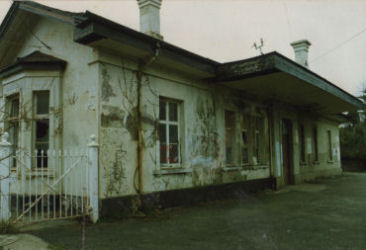
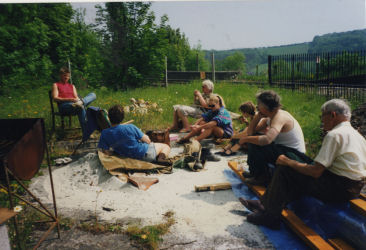
The beginning must start in 1992 when we bought St
Germans railway station as a derelict wreck and got planning to convert
it into a house. It came with an overgrown parcel of land. In 1994 we
found a platform edge in the garden and had an exploratory dig. On
discovering a siding we decided to search for a coach body to go on it
as a guest room for visiting friends.
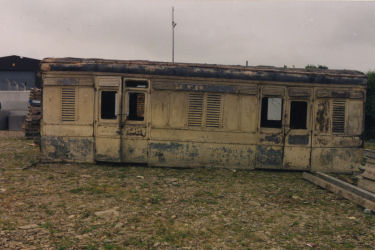
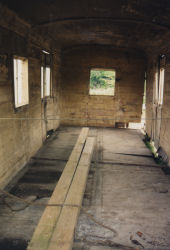
After a while searching, and missing out on a Victorian carriage we
really liked at Liskeard station (that's another story ...) we found the
Old Luggage Van in a builder's yard in Liskeard in 1996. Fairly
derelict but essentially complete, one of the bottom rails had rotten,
and so the floor and side on one side were unattached, so it had to be
secured carefully when we moved it. For over a year we worked on it at a
site near Trerulefoot. We began by stripping the paint inside and out.
We were glad to have the assistance of our friend Mark, who was a
specialist in fitting out Comby vans.
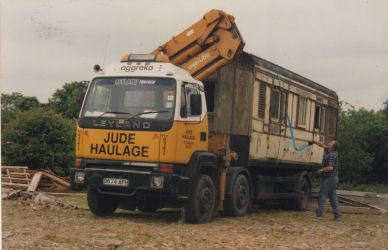
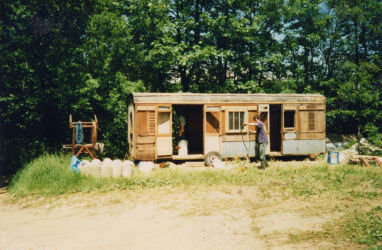
Dave and Steve created a chassis modelled on original drawings. We were
very grateful for the help of Gordon Weddell, author of LSWR carriages
published by Wild Swan publications, for all the invaluable information
he gave us. The siding was excavated. Because it had been used for
cattle the rail had been concreted in for easy cleaning so we were
delighted to find the track still in place.
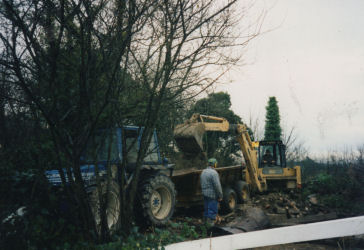
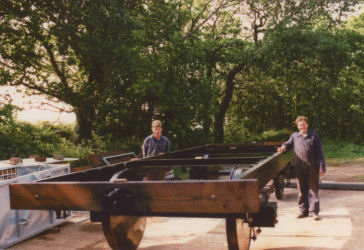
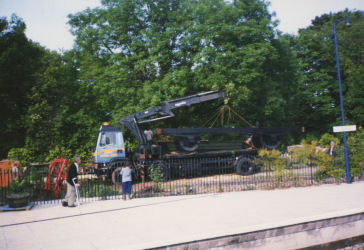
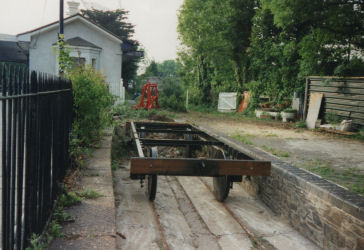
Fairly soon after moving the chassis we were able to take the Old
Luggage Van to St Germans. The inside was again carefully strengthened,
but Dave has done the work to the bottom rail so we were more confident
the move would be successful, which it was. Little were we to know it
would be the first of many more!
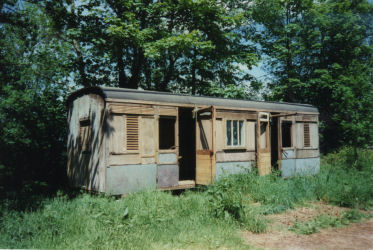
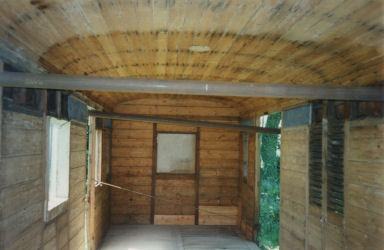
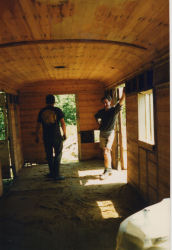
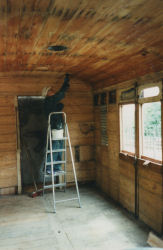
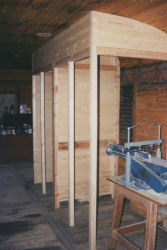
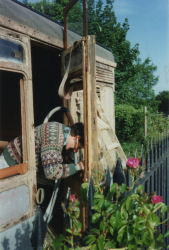
Once in St Germans work continued apace, through the summer and
autumn of 1997. By the winter we'd completed much of the work, and taken
advice on a colour scheme from the wonderful Gordon Weddell of LSWR
carriages fame. We ordered new leather straps for the window from a
local leather worker and retained all the original features we could,
including the interior perforated zinc panels and exterior door handles.
The inside was Danish oiled and looked lovely, a job that we repeat
each year.
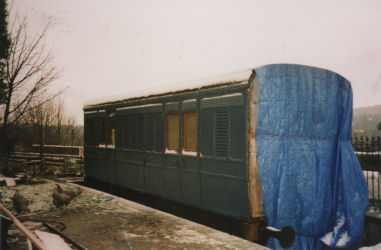
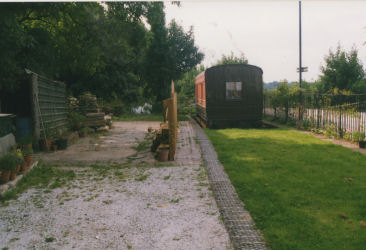
The finished Old Luggage Van was fitted out to sleep families of up
to four (although we did occasionally have brave groups of five!) It had
a seat that converted into a double bed or two singles, a separate
shower and toilet, two bunks and a small lobby.
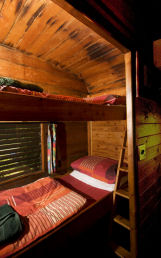
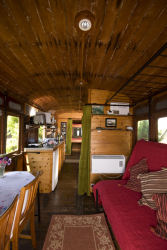
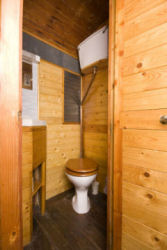
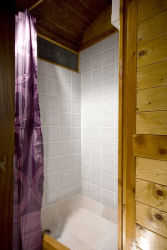
We advertised in the Railway press and in July of 1998 welcomed our
first guests. The garden was simple and we felt very much like novices.
However when word got around on what a great place it was to trainspot
we soon got good publicity and a healthy flow of bookings; appearing in
The Times, Home Building and Renovating Magazine, local papers and on
BBC breakfast news. These were the days when class 37s were still in
mainline service and the Post Office train sped by twice a day.
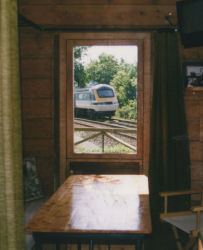
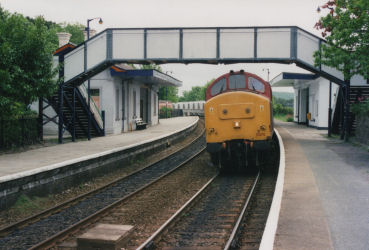
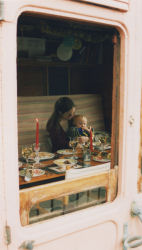
In January 1999, six months after opening we were delighted by the
arrival of Walter, who was born in St Germans station and quickly
developed a passion for trains. And so began our education in engine
numbers and the names of Thomas the Tank Engine and all his friends!
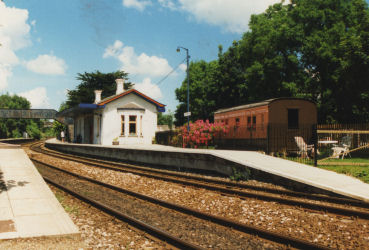
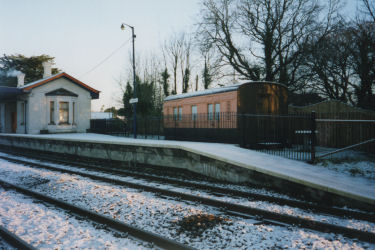
The business continued comfortably, we expanded with the SK2 at
Hayle in 2001, while expecting our daughter Poppy. All was delightful
and easy until we had the idea of expanding further in St Germans. We
searched for a thirty foot coach, but fell in love with the 48 foot long
Travelling Post Office, which was far to big for the site we were
preparing to lease at the other side of our station building.
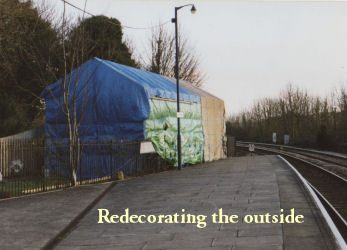
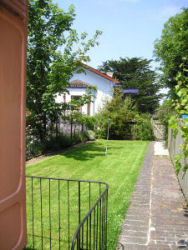
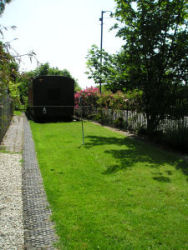
After much head scratching and a reluctance to change what was a
successful arrangement we finally decided to move the Old Luggage Van to
the new site, to free up the siding for the Travelling Post Office.
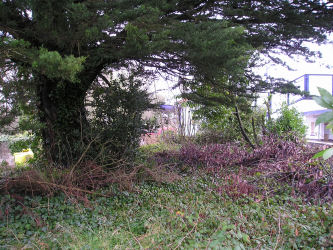
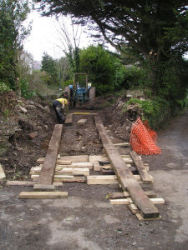

This fun move involved pulling the carriage behind our 1952 Fordson
Major tractor, adding a few feet of track in front of the carriage with
each pull, and a day doing something technical with rollers to line it
up into the right position.
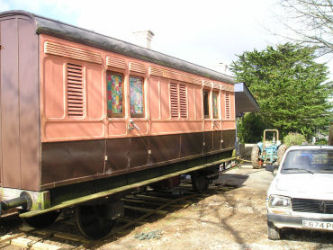
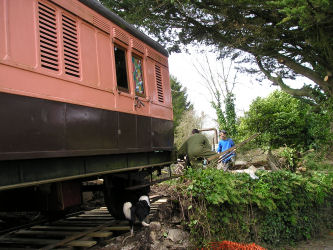
This was in the spring of 2006 and just to add a little theatre the
new rail franchise had come out, threatening to cut the services at St
Germans from 12 each way to 6. We ran a successful campaign to overturn
this, but perhaps our most surreal moment of the business must have come
when Lizzy was interviewed on the television for the local news and the
subject of the holiday business came up. The Luggage Van was parked in
front of the house behind Lizzy, while Dave and Lizzy's cousin Malachite
walked back and forth with sleepers like a pair of burglars!


While the Luggage Van continued to be popular, we felt after the advent
of the grander TPO that it slightly fell into its shadow. As our first
venture, we'd wanted to sleep a family of four as we felt this would
offer the most possibilities, which at the time it did, and we made
many close friends and watched their children grow. However now we felt
with families well catered for we would be better to adapt it as a
retreat for singletons and couples, taking advantage of the cosy garden
and the line side view.
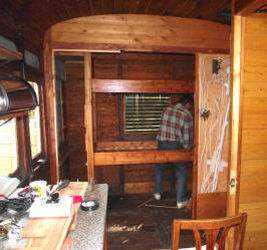
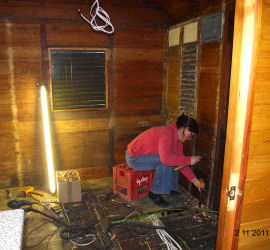
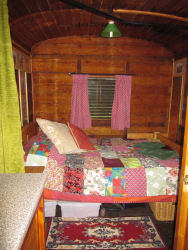
Again after much soul searching in November 2011 we upgraded the
Luggage Van. We began on the bedroom by taking out the bunk area,
rewiring the electrical cables, ordering prints to decorate the walls
and making a patchwork throw. We bought the most comfortable mattress we
could find and added a decorative curtain rail around the area to make
it extra cosy.
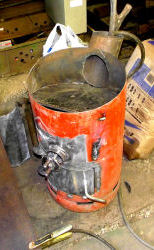
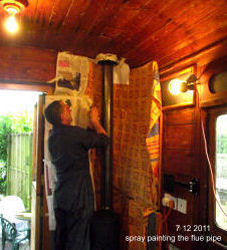
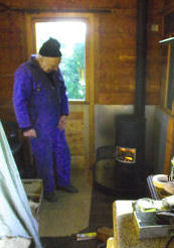
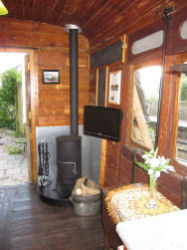
In the sitting room we removed the old sofa bed arrangement and
found comfortable fireside chairs to go with the wonderfully effective
wood burning stove that Dave made from an old gas cylinder. We finished
the look with an Edwardian side table and new lampshades, that we later
replaced with glass shades to add a more authentic railway look.
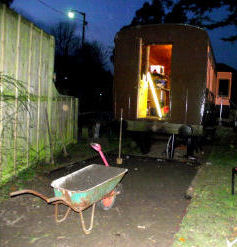
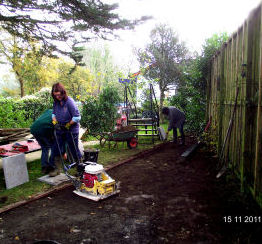
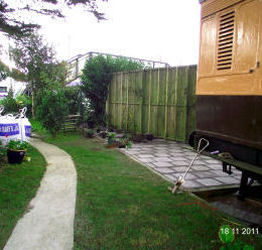
Grass had always struggled in the Old Luggage Van garden, as the
impressive macrocarpa tree keeps the soil dry and often shaded. We added
a patio area interspersed with a fine mix of perennials and shrubs for
all year round structure and interest and filled the lawn with spring
bulbs. We were ably assisted in our work by Lizzy's sister Nic, Dave's
father John and our friend Lil, who proved to be a friend at laying
patios. This renovation was a great decision and the Luggage Van is justifiably popular. The garden was completed with our log shed, so our
guests need never worry about running out of fuel.
In 2017 Port Eliot estate took down the Macrocarpa as it was causing problems with a supporting wall. Without the shade and competition for water, the garden is now flourishing. In 2025 we planted hundreds of snowdrops, which should make for a fine winter display.
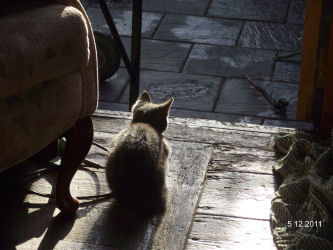
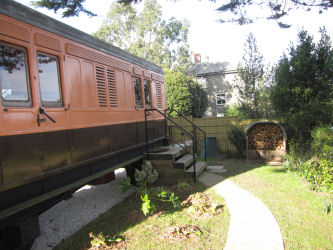
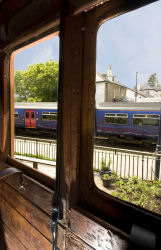
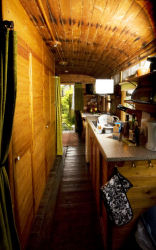
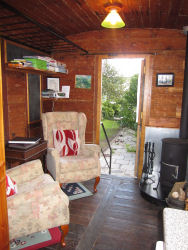
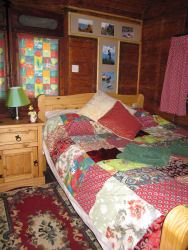
Harvey
Harvey is a BR Mark 1 Corridor Second coach built in 1957 at Wolverton carriage works to diagram number 146. Its first number was 25355 of lot number 30349. Taken out of service in 1983 it was purchased by a private buyer who began the external restoration on a siding at the Bodmin and Wenford railway. We bought it in 2000 and converted first the West End, which was the subject of a five part programme on Discovery Channel called Amazing Conversions, a Wall to Wall documentary. The coach was completed and moved to Hayle in July 2001. The following year we converted the East End. Internally we were able to retain most of the original features. The seats were re-upholstered in 2012 with the original Trojan Blue mocquet.
In 2013 we changed the name from 'The St Ives Bay SK2' to 'Harvey', which is a nod to the world famous foundry, Harveys of Hayle, the builders of Richard Trevithick’s first locomotive engine.
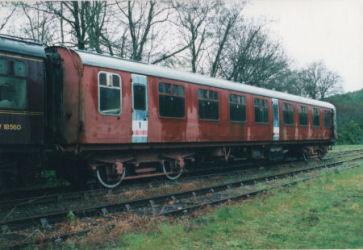

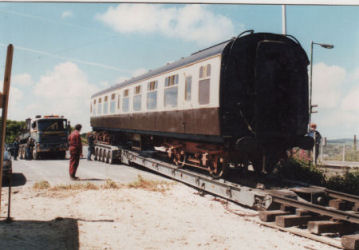

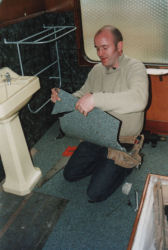
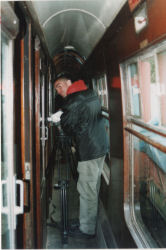
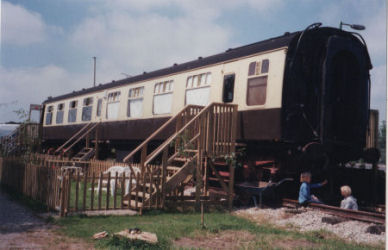
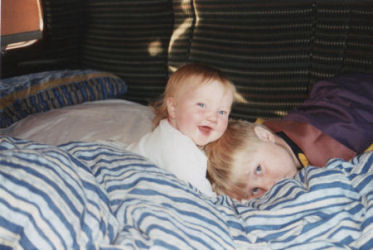
The Travelling Post Office
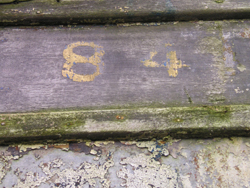 Our 1889 GWR clerestory roofed travelling post office number 841 ( built as number 2086 ) originally had broad gauge bogies and a narrow body. It was converted to standard gauge in June 1891. It was withdrawn in 1934 and for many years formed part of a house in Wales.
Our 1889 GWR clerestory roofed travelling post office number 841 ( built as number 2086 ) originally had broad gauge bogies and a narrow body. It was converted to standard gauge in June 1891. It was withdrawn in 1934 and for many years formed part of a house in Wales.
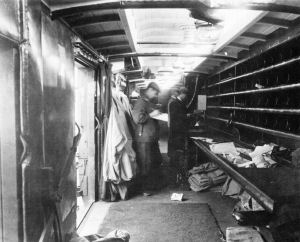 The internal view is of TPO 838 which appears to have been the same internally as 841. The photo was taken on 9th January 1900 just as more mail has come aboard the 'up' Bristol-Penzance TPO.
The internal view is of TPO 838 which appears to have been the same internally as 841. The photo was taken on 9th January 1900 just as more mail has come aboard the 'up' Bristol-Penzance TPO.
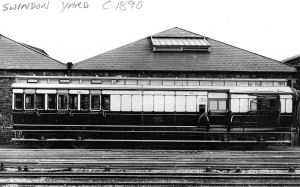 The external view is not TPO 841 but is included to show how it would have looked as built with 3 third class compartments at one end. Whilst we were replacing some panels the original door frames could clearly be seen.
The external view is not TPO 841 but is included to show how it would have looked as built with 3 third class compartments at one end. Whilst we were replacing some panels the original door frames could clearly be seen.
A Few Diary Entries
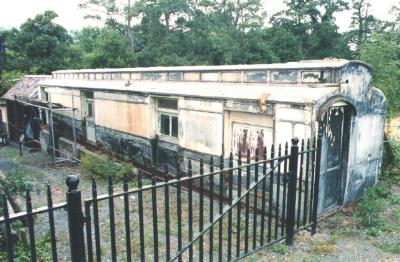 12th November 2004 - Cranes in Wales and Cornwall and a low loader from Moveright International are booked
so the TPO should be with us in St Germans on Wednesday 24th.
12th November 2004 - Cranes in Wales and Cornwall and a low loader from Moveright International are booked
so the TPO should be with us in St Germans on Wednesday 24th.
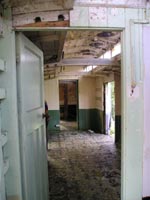
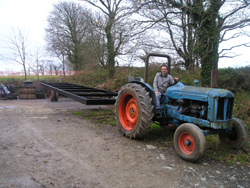 In preparation for this, work on the chassis has been progressing at a frantic rate. The plan is for the chassis to have a temporary road axle and drawbar
so that the TPO can be moved onto its site by tractor once the conversion work is complete. It will be fitted onto the bogies on site.
In preparation for this, work on the chassis has been progressing at a frantic rate. The plan is for the chassis to have a temporary road axle and drawbar
so that the TPO can be moved onto its site by tractor once the conversion work is complete. It will be fitted onto the bogies on site.
26th November 2004 - Well we made it! The TPO is now parked outside my workshop but along the way we had a few trials and
tribulations. We went to Brecon on Monday to jack it up from the steel frame that it was resting on in preparation for getting
the strops around it. It was only possible to jack at one end but it is very rigid and didn't sag at all.
Tuesday AM saw a
50t crane from Jay and Davies of Hereford and the low loader from Moveright/Heanor arrive. It took only minutes to lift the TPO onto the lorry
but then a slight problem loomed in that the trailer at 80' long was too long to turn and so it was necessary to reverse the 2 miles back to the
main road!

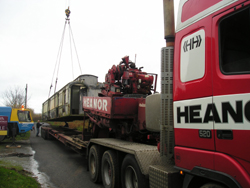
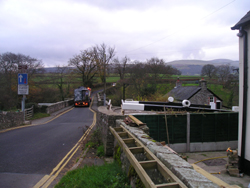
 The lorry arrived in Cornwall the next day and things would probably have gone smoothly had it been able to get around the corner before the proposed site for unloading. After an impromptu change of venue and another half a mile of reversing the TPO was successfully transferred to its new chassis. It was then moved by tractor to the workshop. Quite a draining couple of days!
The lorry arrived in Cornwall the next day and things would probably have gone smoothly had it been able to get around the corner before the proposed site for unloading. After an impromptu change of venue and another half a mile of reversing the TPO was successfully transferred to its new chassis. It was then moved by tractor to the workshop. Quite a draining couple of days!
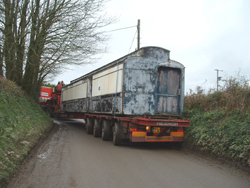

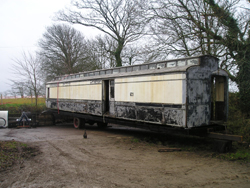
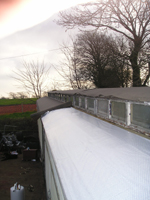 10th December 2004 - The first priority has been to get the tpo weather tight as the original canvas roof covering had gone.
The roof structure is single skinned 1" timber and so insulation was used under the roofing felt to help reduce both
heat loss in the winter and gain in the summer.
10th December 2004 - The first priority has been to get the tpo weather tight as the original canvas roof covering had gone.
The roof structure is single skinned 1" timber and so insulation was used under the roofing felt to help reduce both
heat loss in the winter and gain in the summer.
February 2005 - We have had a couple of dry weeks and so the emphasis has been on the outside. The clerestory windows have been sealed around and painted which seems to have stopped the few leaks that we had. New glass has been obtained for the broken windows.
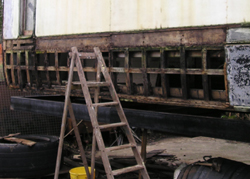 Standard railway practice was to replace the mahogany outer skin panels with galvanised steel sheets and this has been done to most of the TPO. Some of these were coming away from the frame work and so they were replaced. The new panels were taken up under the top ones to prevent water ingress instead of butting
together as before. In due course mouldings will be fitted. I have made these before for the luggage van from marine ply which
seems to work well. A new section was scarfed into one of the ribs.
Standard railway practice was to replace the mahogany outer skin panels with galvanised steel sheets and this has been done to most of the TPO. Some of these were coming away from the frame work and so they were replaced. The new panels were taken up under the top ones to prevent water ingress instead of butting
together as before. In due course mouldings will be fitted. I have made these before for the luggage van from marine ply which
seems to work well. A new section was scarfed into one of the ribs.
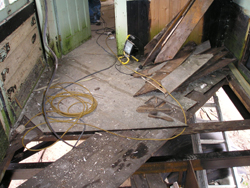 The floor in some areas has rotted and is being replaced. Originally there were 2 layers of opposing diagonal boards. Plywood is being used for the under layer with new t&g for the top layer laid diagonally as before. Getting the new areas to blend in with the original will be a challenge.
The floor in some areas has rotted and is being replaced. Originally there were 2 layers of opposing diagonal boards. Plywood is being used for the under layer with new t&g for the top layer laid diagonally as before. Getting the new areas to blend in with the original will be a challenge.
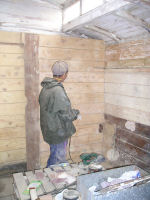
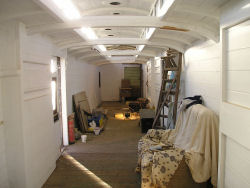
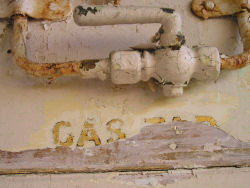
November 2005 - OK so I've never been much good at keeping a diary but here is the belated latest instalment! The inside has been completely stripped, repaired and primed. The 2 (non original) partitions have been removed and the floor re-laid with diagonal boarding stained to match the 2 original sections. One new window droplight has been obtained from our local joiner.
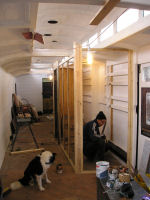

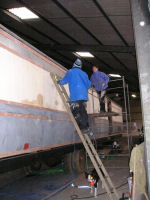
January 2006 - The wc/shower room is complete except for tiling the shower tray and a bit of plumbing and the
bunkroom is finished but needs a couple of doors. The double bedroom is finished except, again, for a door.
I feel a door making session coming on! Work is currently progressing well on the kitchen.
The schedule at the moment is to have the wiring done within the next couple of weeks, with the internal work
finished by the end of February. Then move the TPO undercover for a couple of weeks to sort out
the outside. Then move it onto site mid March.
February 2006 - The TPO is now undercover in a large grain shed so that we can work on the outside. After repairs and
panel replacements, mouldings to the original pattern are made from marine ply and fitted. Internally things are pretty much complete and the wiring is underway. Still no doors yet though!
Mevy
A diary from the aquisition of Mevy in 2010, to completion in July 2013
We acquired Mevagissey in November 2010. It was at Buckfastleigh on the South Devon Railway, where it had been stored for many years. Clad entirely in cedar with a pitched roof, there was nothing to indicate this shed was a carriage. Inside it was clad through out with hardboard and carpeted. It was a little damp, but essentially sound. After being taken out of service in the 1930's it had been used as a house in Mevagissey, hence the name, and had moved twice before being stationed at South Devon.
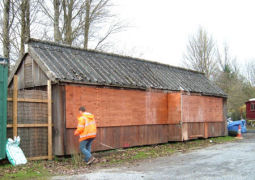
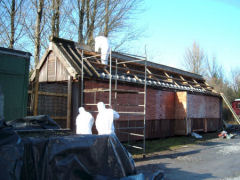

There was plenty to do on site before we were ready to welcome Mevagissey to St Germans. Wheel sets were acquired from Plym Valley Railway and a chassis was created for the coach to sit upon. The siding was extended and built up. There was plenty of shunting of carriages up and down the line in anticipation of the new arrival.
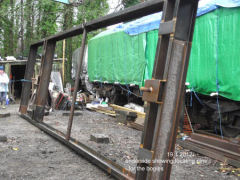
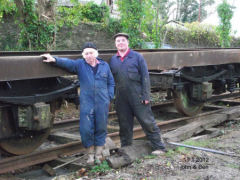
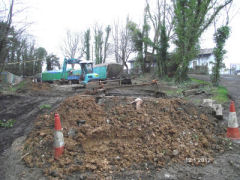
In February 2012 we were ready to move the coach. As is the way with coach moving, it was always unlikely to go exactly according to plan! It was an extremely cold February day with very hard frosts. We arrived early to get ready for the trailer, which was due at 9.30. The crane was there by eight and all was going swimmingly until the lorry failed to materialise. It turned out his brakes had frozen solid and another lorry had to be tracked down, which finally made the scene at midday. We were very grateful to the friendly staff at Buckfastleigh who kindly showed us around their fascinating engine works room. The warm cafe with home made cakes was also much appreciated! After that things went well - the drop off at St Germans went without a hitch and we were able to celebrate what we anticipate will be our last carriage move!
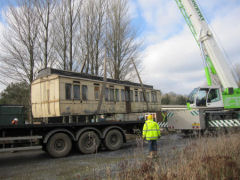
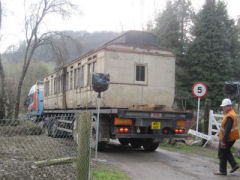
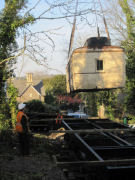
Once in St Germans, John set to removing the carpets and hardboard from inside the coach, while Dave and the team were busy ensuring it would be watertight. The roof was clad with galvanized steel sheet, which involved Dave in the creation of a special bending machine. A temporary platform of reclaimed scaffold boards was erected around the coach so work could be carried out more easily.
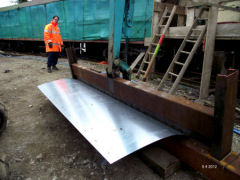
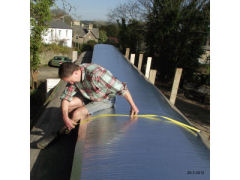
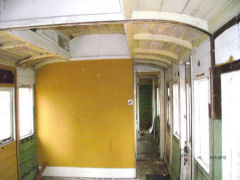
Once the roof was watertight, the team set to on the outside, replacing the rotten panels and renewing the mouldings, taking the opportunity to insulate in every possible cavity. Meanwhile John began a task that would keep him busy for the next seven months - stripping paint and sanding back the woodwork.
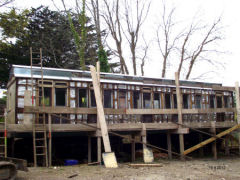
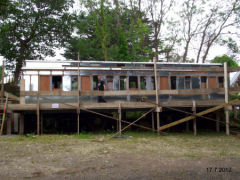
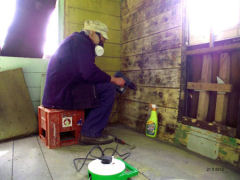
Because the carriage had been clad many of the ventilator covers had been removed, so Dave and Nic set about re-creating copies of the original. Soon the LSWR woodwork coach was filled with sawdust and the router put to good use. Meanwhile John's stalwart stripping continued ...
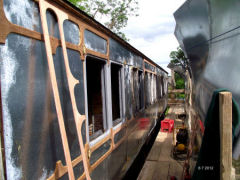

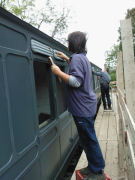

And so more panels off, more insulation in. Some parts of the outside work are more challenging than others - notably the curved wooden beads at the end of the coach. 2012 has not been a year in which sunshine featured highly. Consequently exterior work was somewhat hampered by a lack of break in the clouds. However whenever the sun was out the panel replacement and exterior work continued apace. In the autumn the team erected a canopy to help stave off the worst of the weather and while we had been optimistic that the external work would be complete by the end of the year rain has slowed play and so although the majority of the outside has been done by January 2013, it will be continuing into the New Year.

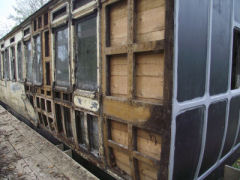
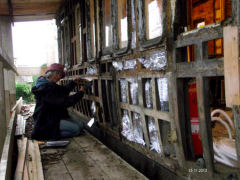
In October 2012 Dave began work on the drop light windows, a time consuming task that will provide many weeks entertainment. The fixed window panels are stripped off and done up, window latches and hinges fitted up, brass work polished. The mouldings were taken out of the first class compartment and sanded down ready for the next stage. John was delighted to finally down the sandpaper and pick up a paintbrush. With this marks the beginning of a new phase - with most of the internal restoration complete, the fun job of fitting up can now begin. Roll on the summer!
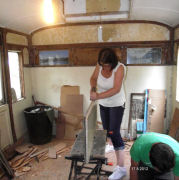
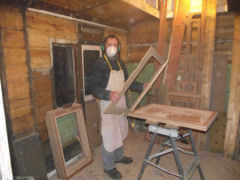
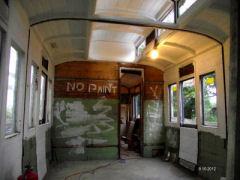
Much of February 2013 has been spent on renovation - completing insulating the exterior, adding the panels, making the mouldings, grouting and filling the gaps. Dave has fitted up the doors (a job that has been larger than it sounds!) We've also been filling and sanding inside.
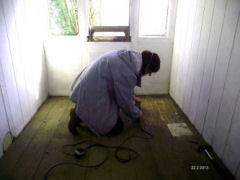
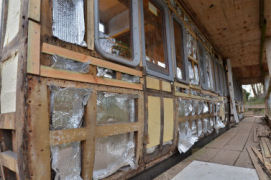
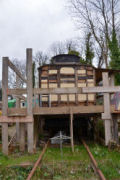
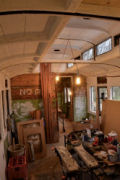
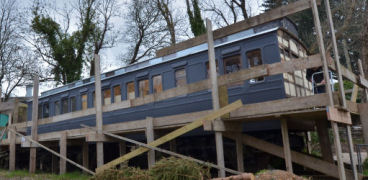
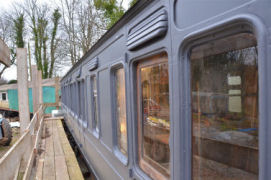

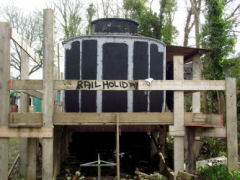
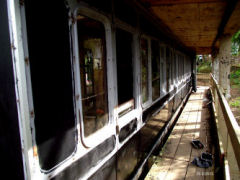
March 2013 and the first class compartment is now well underway. We have put up the ceiling panels and the mouldings. Ben has added panelling in the old toilet areas and on Friday our upholsters, Selina and Paul Luscombe of Luscombe Upholstery came to test out their templates, so the bed and side panels will be complete by the end of the week, then stored until we are ready for them. They also took away the curtain material and will be creating the curtains in the next few weeks. The choice of upholstery material took a fair bit of mulling over - but in the end we are delighted with what we have got, which for both first and second class is really sumptuous and in keeping with the character of the coach. Carpet choosing is underway and today a friend is coming over to teach Lizzy how to guild the mouldings.
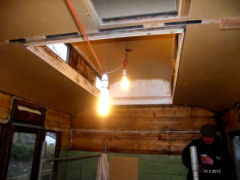
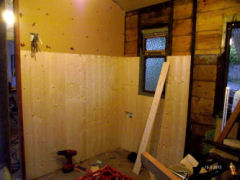
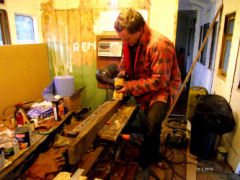
The outside is now complete, except for the final coat of chocolate and cream paint. The channel has gone in for drainage and the garden is underway.
The children's bedroom is awaiting the bunks, which are being made by Paul Ager, who is also creating a signal box play house for Hayle and bespoke luggage racks and curtain poles.
The bathroom floor has been filled, sanded and Danish oiled. We've chosen the panelling and are now contemplating light fittings. The bath is waiting to be fitted and we plan this week to choose the sink and toilet.
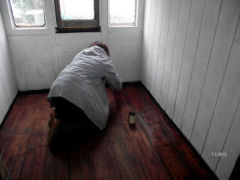
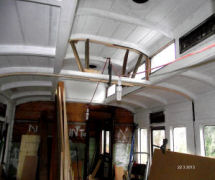
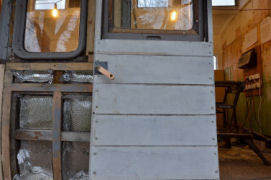
April - The bathroom has moved forward really well from being an empty room to a fabulous light space with respatex panels, high rise cistern and bath with ball and claw feet. Just waiting for the plumbing so we can use it! The wiring has gone up in the living area and the bedroom and living room furniture has been made and is awaiting our command. We've decided to leave fitting it for as long as possible to ensure it stays immaculate. We wanted to recreate the beauty of the 1st class compartment, so with the wise guidance of Sarah, a gilder who now runs Essential Decoration Lizzy's been playing with tissue thin sheets of pure English gold. It's been a learning curve, but we are pleased with the results.
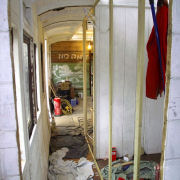
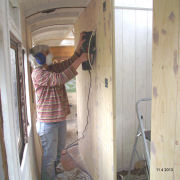
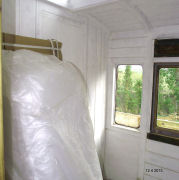
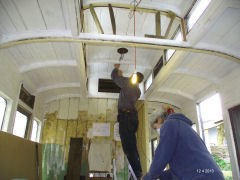

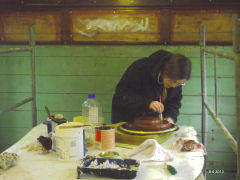
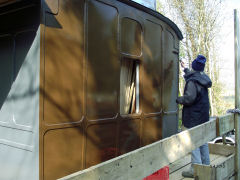
May and the team have been working with all hands to the deck - we're really pleased (relieved) with the progress we're making. As I write (7th May) the 1st class compartment has gilded panels and most of the painting complete. The bathroom is almost finished -just awaiting decorative brackets for the cistern and a shower curtain rail. We were delighted to find a curved towel rail to fit into the small space allocated, and it looks very stylish. The sunny weather has enabled us to give the outside two coats of brown paint. Dave and Nic have now moved on to make a really good start in the kitchen, while John restores the doors, Kath sands and fills and Lizzy sorts out the finishing touches.
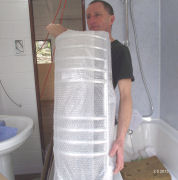
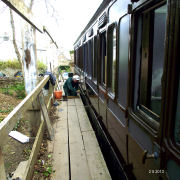
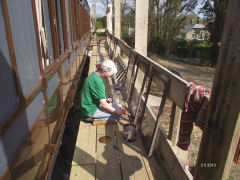
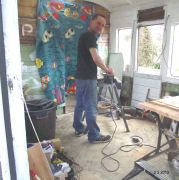
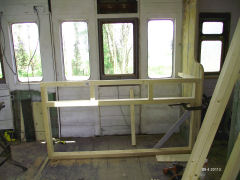

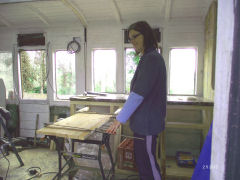
June 4th and work is so busy there's little time for blogging! Mevy is now a beautiful cream and brown. The top vents are going on ready for the move to its final position. Our electrician Richard Elliott and plumber Mike Eastment have both been hard at work this week adding the services. The gilding in first class is almost finished, save a little around the picture frames, which will be finished later this week. The garden now has a beautiful hazel fence and we've put in the gate and later today will add fencing panels to complete the garden. Our talented blacksmith friend Paul Ager has measured up for the bespoke beds in the bunk room and will be making them later this week. John is fitting up the doors and in two weeks the bespoke furniture for the bedroom and living room will be fitted by Luscombe Upholstery. It's looking good, but we won't be resting on our laurels until our first guests arrive on the 5th July!
June 10th and less than four weeks to go - the countdown begins! It's been ground force here the last few days - so much progress I'm exhausted just thinking of it! The carriage is now in its final resting place, the ground has been levelled with the kind help of David and Emma Lock, who have been absolute stars this weekend, and the turf is laid. The fence is begun, the entrance planted and mulched.
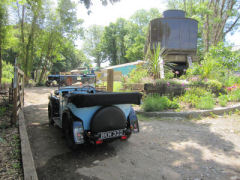
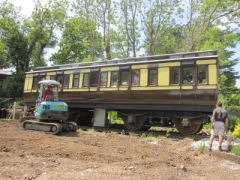
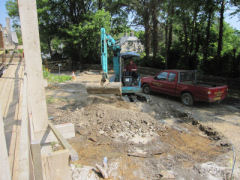
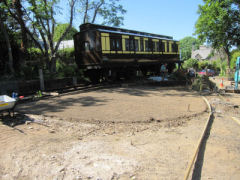
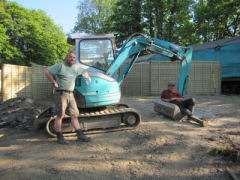

John's making a lovely job of the internal doors and has sanded and varnished the table to go in the bedroom. Lara has caulked the guard's room and begun painting and Kath's been on ceilings. The ventilators are on and we're hoping now we've removed the scaffolding we won't notice something we might have missed!
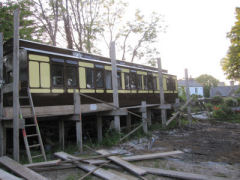
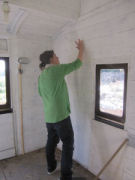
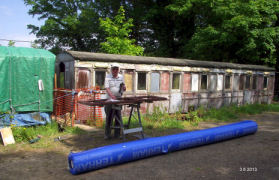
July 15th - Well we just about made it for July 5th! In the week before all our kind family and friends pulled out all the stops. The garden was levelled and laid by our good friends Dave and Emma Lock. Dave also was fantastic in putting up the fence panels, decking posts and lots of other garden work. Emma's sister Katy came over with a beautifully hand painted sign and made a path through the garden. Lizzy's father Tony Lister did some great fencing work and Lizzy's Mum Frankie Lister helped with the patchwork throws. Paul Ager arrived with the most magical triple bunk bed. Ben came down specially from Immingham with his very helpful girlfriend Melissa and laid the tarmac and helped get the decking up, along with Claire, who gave up her Sunday to help us. Thanks to Richard Elliott for the electrical work and Mike Eastment for the plumbing. However none of this would have been possible without Lizzy’s ever competent and reliable sister Nic and Dave’s father John, who have been the backbone of the team from the very beginning.
On the Friday there was much last minute polishing and nailing - we had a full team gratefully augmented by our master painter and Tai Chi coach Kath, who passed with friends and concluded we needed an extra pair of hands to clear the deck (literally) that was several feet high in discarded boxes and power tools. Our guests arrived to a scene of much busy-ness. Poppy cut the ribbon and Mevy the Slip Coach was formally declared open!
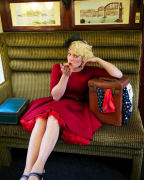
Millpool
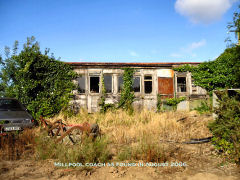
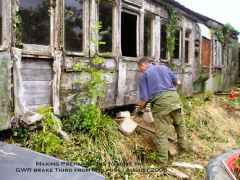
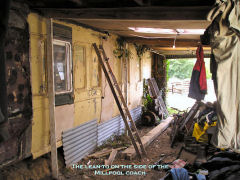
The Millpool story begins in 2002 when Lizzy and three year old Walter were visiting the Hayle model societies annual exhibition, which at that time was held in Foundry Village, then known as Pratt’s market. We got chatting to a chap called Jon Wood, who was impressed by Walter’s knowledge of engine types. It turned out Jon was an expert in the whereabouts of grounded carriage bodies in the Penwith area. Four years later we decided to find more carriage bodies to restore, so called Jon for a tour of the far west. It was a rather depressing trip as so many carriages had been destroyed in the previous four years, but we did find Millpool, still as Jon remembered it, tucked away in a farmer’s yard. The timing was perfect ‐ the farmer was happy to sell and the coach was still in good condition.
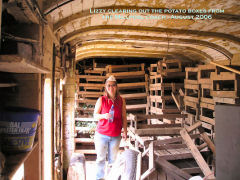
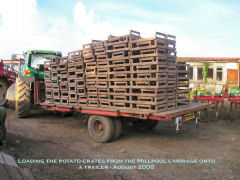
One of my least favourite jobs of the whole carriage restoration process must have been removing and stacking the hundreds of potato boxes onto the farmer’s trailer before we could move the coach. It was bakingly hot and unbearably dusty.I vowed I would never move another potato crate in my life! Walter and Poppy watched and waited patiently when we moved the carriage - they were seven and four years old at the time.
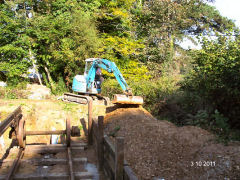
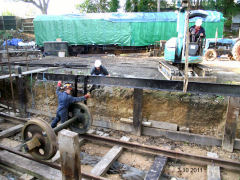
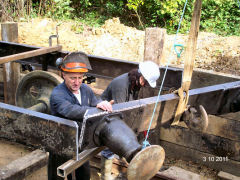
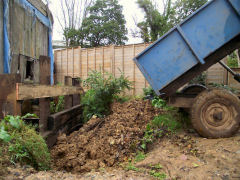
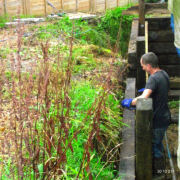
We moved the coach, a GWR brake third, to temporary storage, while we prepared the new site in St Germans. This involved several years of work, but finally Millpool arrived in its permanent home in 2011. The chassis was made by Railholiday, the wheels were sourced from Plym Valley Railway. For more about the coach on the Vintage Carriages Trust’s website, click here
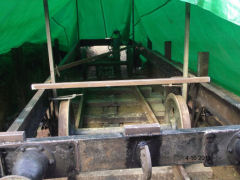
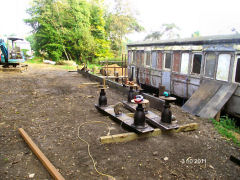

As usual the moving was an entertaining mixture of excitement and stress, with the inevitable traffic jam in the centre of the village. We were of course pleased when the carriage body was finally lowered into place over the home made chassis.
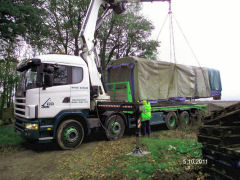
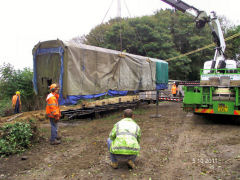
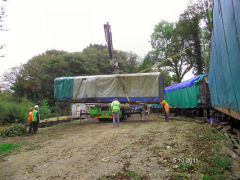
But of course we had our usual trusty team on hand to help! John, Dave, Nic, Ben and plenty of friends and family came along to help with cups of tea and moral support.
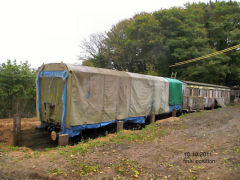
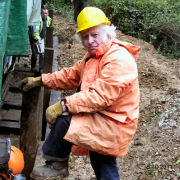
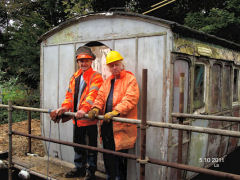

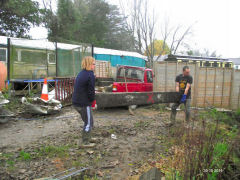
Millpool has waited patiently for work until September 2014 when John began the paint scraping.This is going well - as I write on the 6th January most of the paint has been scraped away and much has been sanded. A bridge, platform and polytunnel have gone up so that work can begin on the outside.
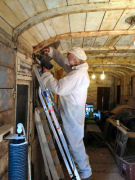
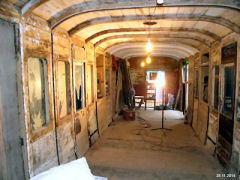

2nd March 2015
While there is not much to show, the paint stripping is almost complete
inside and work has begun on the outside. So far John has removed the
rotten panels so we can insulate behind, and has paint stripped all the
exterior panels that can be saved. Kath has primed the bare wood to keep
it safe.
March to June 2015
The panels are removed and we begin to tackle the woodwork, using sweet
chestnut planks from our own woodland, sawn up in Ron Craddick’s sawmill
in St Germans.
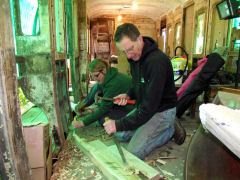

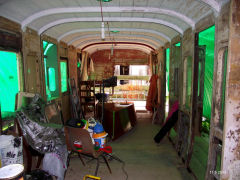
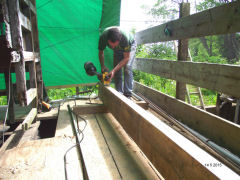
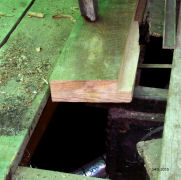
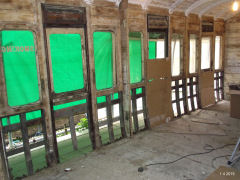
June to August 2015
Work continues, sawing and carving. We are assisted by the arrival of
our long term apprentice Ben in August, who moves to Cornwall from
Imminham to join the team permanently.
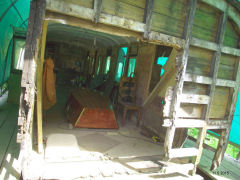
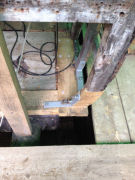
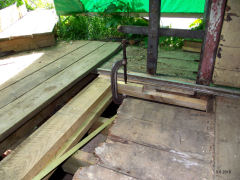
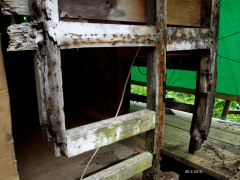
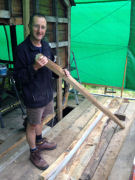
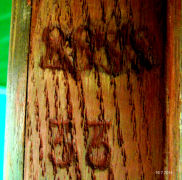
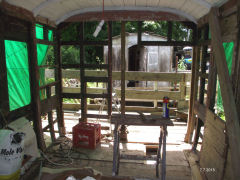
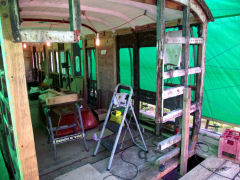
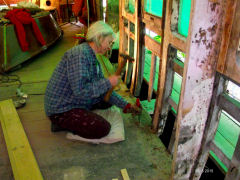
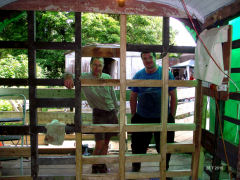
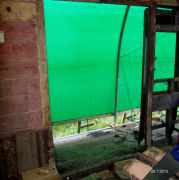
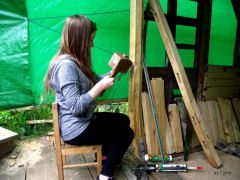
September to December 2015
Even more sawing, sanding and carving, with the addition of painting and stuffing behind the panels with insulation too, to add to the variety. Millpool has been fully insulated underneath, and the guard’s end is now complete and a matchboard cladding has been added inside, and galvanised steel panels now protect the exterior. There has been an incentive for this work, as with the end exposed the wind and rain was whistling through. Ben has set up his stove and the workers are now toasty and warm.
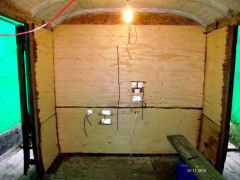
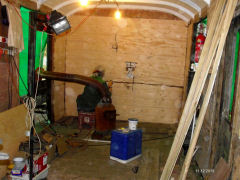
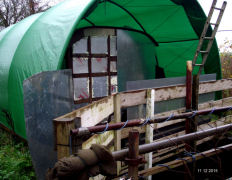
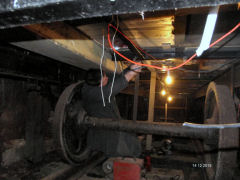
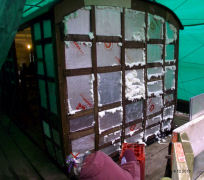
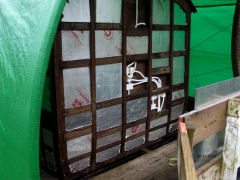
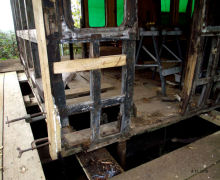
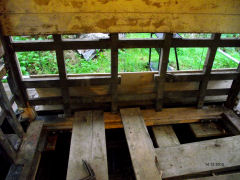
18th January 2016
This page has been pretty static, but now things are starting to happen!
Restoration work is pretty boring to view; days can be spent carving a
small piece of chestnut to mend a rail that then will be covered and
never seen again.
Over the last ten months work of this nature has been taking place. Once
the panels were removed we discovered the coach was in considerably
worse condition than we had hoped, and much of the structural woodwork
was very rotten. this has been patiently removed and sweet chestnut from
our own woodland has been shaped to take its place.
August 2016
The structural work, which has been very time consuming, is now
complete. The duckets have been sanded and mended. The structure for
beneath the wet room has been created. Dave, with the help of our good
friend Mark and his special machine, has managed to carve the pieces
needed to mend the doors. Everything has had a prime of white paint. An
emergency exit has been made in the end. So although there is still not a
lot to see, the next stage should take place relatively quickly.

Our vision for this coach is to provide a fully wheelchair accessible
holiday carriage with provision for those with impaired hearing and
vision. There will be a dedicated car parking space adjacent to the
carriage with level, step free access to the accommodation. The
accessible patio and sensory garden has a view over rolling hills.
 The carriage will be equipped to the Visit England M3I, V1 and H1 National Accessibility Scheme standards. For more information on the carriages accessiblity please view our access statement. Millpool can be booked now either online or over the phone for holidays starting from the end of October 2017.
The carriage will be equipped to the Visit England M3I, V1 and H1 National Accessibility Scheme standards. For more information on the carriages accessiblity please view our access statement. Millpool can be booked now either online or over the phone for holidays starting from the end of October 2017.
We have moved onto fitting out the interior and landscaping and work is moving apace. As I write on the 15th September, all the partitions are complete, we have curtain rails (the curtains have were ordered a few months ago and are being handmade in the village), a smart wet room and the kitchen is underway. Lizzy is painting a mural for the bathroom windows and we are looking forward to the next few weeks as the finishing touches are completed.
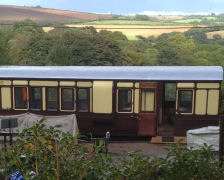
Well, here we are approaching October 17 and we are pleased to report that Millpool is approaching the finishing straits. It has taken much longer than originally anticipated, mainly because Dave will insist on doing everything properly! When we removed the cladding to insulate inside the walls we discovered the frame was very rotten in places so had to be taken apart and remade, with hand carved sweet chestnut from our own woodland. Likewise the doors were rebuilt using reclaimed oak. So all those bits that can’t be seen are carefully constructed micro masterpieces. And we won’t mention the months of paint stripping... (Thank you John!).
Frequently Asked Questions
Is linen provided?
All bed linen is provided and is included in the holiday price.
Are towels provided?
We provide 2 hand towels, 2 tea towels and a shower mat per letting. We do not provide bath towels.
Is your accommodation suited for people in wheelchairs?
Millpool offers fully accessible self catering holiday accommodation that is perfectly equipped for wheelchair users. Mobility aids can be provided if needed.
What sort of accommodation do you provide?
We offer self catering accommodation with a difference in railway carriages beside the railway stations of Hayle and St Germans. The perfect quirky accommodation choice, our carriages are one off holiday homes. Retro but with all mod cons.
When are you open?
We are open all year.
Do I have to pay extra for electricity?
All electricity, gas, water, logs etc are included in the holiday price quoted. We use renewable energy from Good Energy and Octopus.
Are your holidays suitable for single people and couples?
All of our holiday carriages are very suitable for single people and couples. You can just rent one half of Harvey, our largest carriage if you wish.
Do you welcome children?
Children are very welcome all year. The Old Luggage Van and Millpool are generally too small for families, but Mevy, the Travelling Post Office and Harvey are great for children.
Do you welcome dogs?
We welcome dogs in all carriages except Mevy. The gardens of The Travelling Post Office, The Old Luggage Van and Harvey are fully enclosed. The patio area of Millpool which is approximately 2.5m x 3.5m is enclosed but the garden is not. Harvey has a very big garden, while the St Germans carriages have access to ten acres of woodland a ten minute walk away.
Is your holiday accommodation suitable for allergy sufferers?
All our carriages have hypoallergenic bedding. Mevy is best for allergy sufferers as we have a no pets policy for this holiday let. If you'd rather we didn't put in flowers please let us know!
Is you accommodation suited for people with limited mobility?
Millpool offers fully accessible self catering holiday accommodation that is perfectly equipped for wheelchair users and has a Visit England M3 rating. The Travelling Post Office is suitable for anyone with limited mobility and has a ramp.
Is it good for trainspotting and rail enthusiasts?
The Old Luggage Van and The Travelling Post Office are the best carriages for watching trains, as they have a trackside view. Harvey has a viewing tower accessible from the end door of the carriage from which you can see the trains and get a fine view over the roof of the coach to the viaduct.
Can I have a car free holiday? Will I need the car?
Public transport is excellent from both locations; it is easy to explore. There are both buses and trains to choose from at both locations, and footpaths a plenty.
If I do bring my car, are there car parking facilities?
There are good parking facilities at both sites, with free off road dedicated parking spaces.
How suitable are your holidays for people with limited mobility?
Travelling Post Office in St Germans is suited for those with a little mobility. There is a ramp to the door, a mobility scooter can be provided on request. Our newest carriage, Millpool, is designed for wheelchair friendly holidays.
Do you have any facilities for deaf guests?
We have deaf friendly smoke alarm that is provided on request.
Are autistic children and adults welcomed?
Autistic children and adults are always welcome.
Is there anything to see of a railway interest?
We have several carriages in St Germans that we are working on, which make for an interesting tour. We are also within easy distance of the Bodmin Railway (catch a train to Bodmin Parkway), who offer 25% off to Railholiday guests and the Lappa Valley Railway. The Plym Valley Railway in Plymouth and the South Devon Railway are also close.
How close are you to the Cornwall Mining World Heritage sites?
Harvey in Hayle is right in the centre of the Hayle Mining World Heritage site. There are lots of accessible sites in the Lands End area.
How are the carriages heated?
Harvey has mains gas central heating, Mevy and Millpool have central heating run from our biomass boiler, while the Old Luggage Van and The Travelling Post Office both have woodburners. All carriages also have electric heating.
Is fuel provided?
There is an unlimited quantity of wood provided for your holiday and all fuel is included in your holiday price.
Is it warm in winter?
All the carriages are cosy and warm in the winter. All have back up fan heaters too, just in case you need extra localised heat.
Are there things to do in winter?
There are lots of attractions open in the winter. In Hayle Paradise Park is open all year, and has a play barn for children and teenagers (or the young at heart - there is no age limit!). Eden offers winter wonderland skating, there are plenty of cinemas and Truro and Plymouth musueums are both excellent, as is the National Maritime Museum in Falmouth and Porthcurno Telegraph Museum. Cornish gardens have a fine array of camellias, many of which flower from December, and often there are winter food festivals throughout November and December - check our What's On page for details.
I'm flexible with my holiday dates. What do you think is the best time of year for visiting?
My favourite time is April and May, as springtime in Cornwall is particularly magnificent. However there is much to be said all year; wild seas in winter, glorious colours in autumn, lots to do in the summer...The snowdrop walk in our woods is a picture in January and February.
Is the holiday suitable for vegans?
There are many excellent places nearby for vegans to eat. Let us know and we'll put milk alternatives and vegan biscuits in your welcome pack. For suggestions of places to go, visit our food page.
Do you welcome LGBTQ guests?
We welcome all without prejudice.
Where are the nearest shops?
In St Germans there is an excellent community shop and Hayle has a fine selection of small independent shops. For bigger centres, we'd recommend Truro and Plymouth.
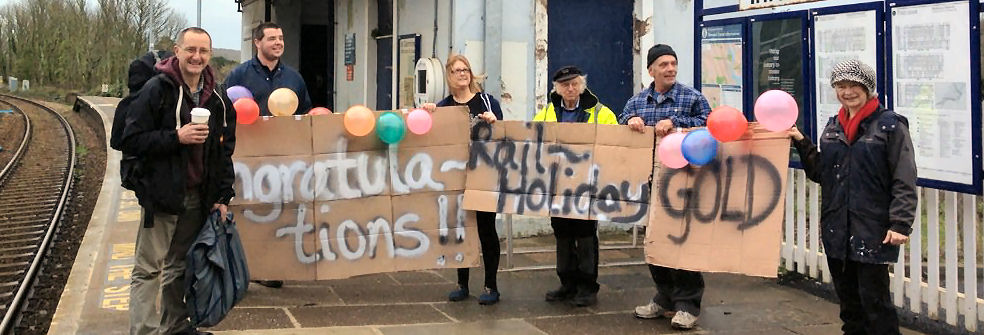
Back to TOP
Contact Railholiday by email at office@railholiday.co.uk or by phone on (+44) 01503 230783. ©


